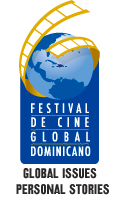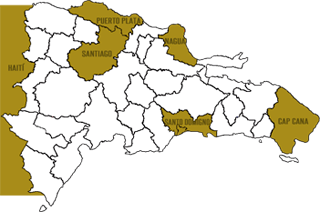
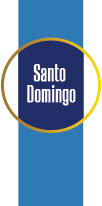 Santo Domingo is the capital of the Dominican Republic. It is a vibrant, constantly developing city of approximately 1,400 square kilometers and home to more than 2 million people.
Santo Domingo is the capital of the Dominican Republic. It is a vibrant, constantly developing city of approximately 1,400 square kilometers and home to more than 2 million people.
Santo Domingo was the first settlement established in the New World and is considered the cradle of evangelization in the Americas.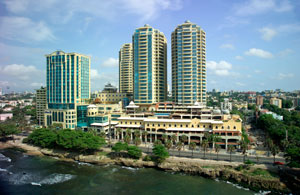 This historic situation has made the city one of the main locations for the filming of movies inspired by events of the 15th century. In recent years, however, Santo Domingo has become a modern city with a developing infrastructure of tall buildings, highways, a subway system and other transportation options.
This historic situation has made the city one of the main locations for the filming of movies inspired by events of the 15th century. In recent years, however, Santo Domingo has become a modern city with a developing infrastructure of tall buildings, highways, a subway system and other transportation options.
Having served as the set for films such as “Godfather II,” “Havana” and “La Fiesta del Chivo” (The Goat’s Party), has consolidated Santo Domingo’s relationship with the Seventh Art.
The sixth edition of the Dominican Global Film Festival will screen movies at several venues in the capital, including the Autonomous University of Santo Domingo (UASD), the main office of the Fundación Global Democracia y Desarrollo (FUNGLODE), the Eduardo Brito National Theater, Palacio del Cine, the Auditorium of the Museum of Modern Art and Plaza España.
FUNGLODE Auditorium
The FUNGLODE headquarters, inaugurated in November 2003, are located in a modern building, set up with the necessary equipment to offer educational, training and scientific activities; to support specialized research projects; and promote the use of information technology.With a capacity of 180, the 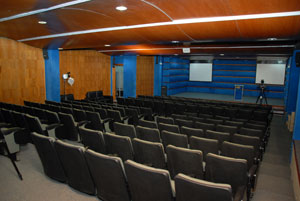 auditorium is equipped for simultaneous interpretation in four languages. It is also equipped with high fidelity sound, television studios capable of live transmission feeds.
auditorium is equipped for simultaneous interpretation in four languages. It is also equipped with high fidelity sound, television studios capable of live transmission feeds.
Cinemateca Dominicana
The Dominican Cinematheque is one of the most prestigious film venues in the Dominican Republic. This seventh art institution functions as part of the General Directorate of Film. Its main goals, in accordance with the Dominican Film Law, is to safeguard the Nation's cinematographic heritage as well as disseminate national and international cinematic values.
disseminate national and international cinematic values.
The Cinematheque, according to its regulations, must promote a critical interest in the seventh art throughout the country and foment research in cinematic material.
This important institution will once again be a venue for the 6th edition of the Dominican Global Film Festival.
Centro Cultural de las Telecomunicaciones
This is the most modern cultural center in the Dominican Republic and the Caribbean. Throughout its four floors, visitors can learn the detailed history of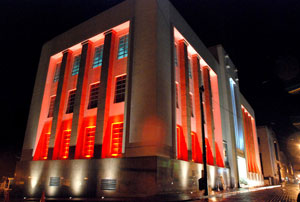 the arrival of the first telephone to the Dominican Republic. The fascinating story of the pioneers of radio and television of our country, the first phones, the first installations and the first users are all on display in these halls.
the arrival of the first telephone to the Dominican Republic. The fascinating story of the pioneers of radio and television of our country, the first phones, the first installations and the first users are all on display in these halls.
The evolution of computers, information technology, the Internet and the latest technology are all here, on Isabel La Católica Street in Santo Domingo. This center also has a media library with more than 75,000 audio and visual documents that can be consulted for the making of an audiovisual documentary of the Dominican Republic.
The Telecommunications Cultural Center has a modern auditorium, with a capacity to seat 144 people. The modern equipment here includes a Dolby Digital 7.2 sound system, a film and HD projector, a 9 x 16 foot screen, two robotic cameras, a simultaneous interpreting system and a video conference system.
Centro Cultural de las Telecomunicaciones
Calle Isabel La Católica Esq. Emiliano Tejera, Ciudad Colonial, Santo Domingo
Tel: 809-633-3333
Instituto Tecnológico de las Américas (ITLA)
ITLA (a higher education technical institution), specializing in technical-professional training, is providing its installations to the Dominican Global Film Festival. Film projections, panels and workshops will be held at their main headquarters on Avenida de las Americas highway. The Technological Institute of the Americas (ITLA) is a technical level institution dedicated to information, communication, production and the optimization of resources and processes that use an advanced educational training system to impart productive values to critical citizens and those wishing to contribute their knowledge to advance technology with the goal of improving individuals as well as society as a whole.
of the Americas (ITLA) is a technical level institution dedicated to information, communication, production and the optimization of resources and processes that use an advanced educational training system to impart productive values to critical citizens and those wishing to contribute their knowledge to advance technology with the goal of improving individuals as well as society as a whole.
Centro Cultural Mauricio Báez
The Mauricio Báez Cultural Plaza, which dates back to 1963 when a group of young people began to build it, is a sports
and cultural complex with an infrastructure unique to the country. Located in the Villa Juana neighborhood, the building houses a club, a health clinic, an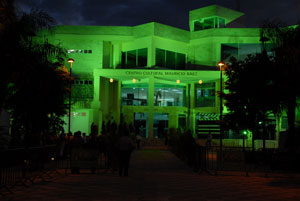 elementary and high school, a theater that holds 425 people and a library, among other things, all of which make this complex a social and cultural center of extreme importance in the city.
elementary and high school, a theater that holds 425 people and a library, among other things, all of which make this complex a social and cultural center of extreme importance in the city.
Centro Cultural Mauricio Báez
Address: Mauricio Báez 175, Villa Juana, Santo Domingo
Tel: 809-238-5386
Palacio del Cine
The Palacio del Cine movie theater chain was born in Santo Domingo in 1970 as an initiative of Gustavo Turull and Margarita Mayol de Turull who, in the early years of their marriage decided to start their own business. This is how the “third run” cinemas got started in the popular areas of Santo Domingo as well as the open-air movie theaters. Some of these open-air theaters were the Coloso, Marlboro, Montecarlo and Cinzano.
well as the open-air movie theaters. Some of these open-air theaters were the Coloso, Marlboro, Montecarlo and Cinzano.
In 1976, the business began to expand with the opening of the “first run” theater: the Palace Cinema on 27 de Febrero Avenue with the new concept of two big screens, each with seating capacity for 500 viewers. Thus, the business has been growing and expanding. In 1986, Palacio del Cine acquired Wometco Dominicana, a company that, at the time, was the owner of the Naco, Triple, Doble and Plaza Movie Theaters.
As time passed and many changes occurred, most of the existing locales became different types of businesses and new multiplex cinemas replaced them. The theaters are more comfortable with their new stadium seating, friendly service, much larger screens and better quality sound thanks to the latest technology that provides viewers with an unforgettable experience.
In Santo Domingo, Palacio del Cine will host the Dominican Global Film Festival in the luxurious viewing halls of the Blue Mall and new projection spaces in the recently shopping center: Ágora Mall.
Palacio del Cine, Ágora Mall
Address: Av. John F. Kennedy Esq. Abraham Lincoln Santo Domingo
Tel.:809-472-2076
Palacio del Cine, Blue Mall
Address: Av. Winston Churchill esq. Gustavo M. Ricart. Santo Domingo
Tel.: 809-955-3086
Teatro Nacional Eduardo Brito
Designed by the architect, Teófilo Carbonell, the theater was created in 1973, as part of the collective project of the Cultural Plaza. Its large stage, the Carlos Piantini Hall, has a capacity for 1,589 spectators.
To assure acoustic quality, the walls are covered by special wood strips. Movable wooden panels facilitate quick change of stage scenery. In addition, the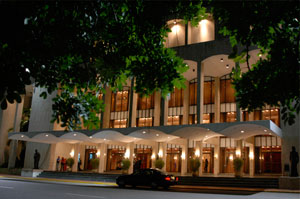 National Theater also has two smaller halls for 200 and 165 spectators, offices, a cafeteria and a service area. The low and rhythmically modulated arches of the facade
National Theater also has two smaller halls for 200 and 165 spectators, offices, a cafeteria and a service area. The low and rhythmically modulated arches of the facade
offer an elegant, classical image. One of the city's metro stations is onsite.
Universidad Autónoma de Santo Domingo (UASD)
The Autonomous University of Santo Domingo (UASD) was created through the Papal Bull In Apostolatus Culmine, on October 28, 1538, decreed by Pope Paul III, making it the oldest University in the New World.
Paul III, making it the oldest University in the New World.
Manuel del Cabral Hall, with seating capacity for 360 spectators, will be one of the venues for the Film Festival. This hall is part of the Pedro Mir Library, which was conceived with the objective of functioning as a resource center to provide support for teaching, learning and research in service of the UASD and the country.








